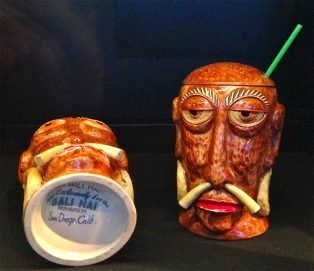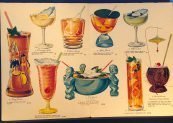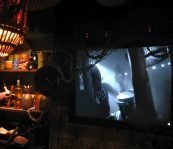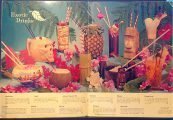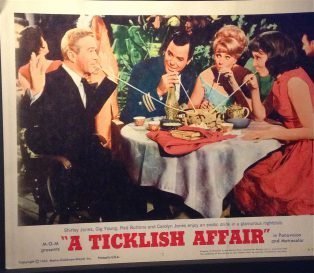Aloha, Shaded Viewers,
On the last day of my Paris holiday last month, Diane suggested we catch the last day of the superb TIKI POP exhibit at the Musée du quai Branly. Boy, am I glad we did! Not only was it an impressively thorough collection of Tiki artifacts and data, it was also a neutral French analysis of something that is deeply ingrained in Americana kitsch culture. Emerging sometime during World War II, Tiki culture in the U.S. (Tiki bars, Polynesian restaurants, “exotic” lounge music) had its heyday in the ’50s and ’60s, with the pu-pu platter flames starting to wane and die out in the 1980s–but that doesn’t mean there isn’t a thriving cult today (especially in LA and San Francisco), not to mention a few old-school places left in my neck of the woods.
Tiki culture in America was a fantasy based on the allure of exotic places that many Americans did not have the means to travel to. During the 1950s, it was a release from the stress of “keeping up with the Joneses”, featuring the soothing sounds of Martin Denny and mysteriously strong cocktails that provided a weekend panacea for the middle class–especially the men. (Hello, hula-girl sex fantasies!)
Tiki was the first man (a quasi god or Oceanic divinity) in Maori culture (the indigenous people of New Zealand) and generally became known as a humanoid carving throughout all of Polynesia. By the by, I traveled to New Zealand in 2003 to write a feature on the Maori for WestEast magazine. You can read the story here.
My memory of Tiki culture goes back to my early childhood when my parents and I would make regular excursions to various Polynesian restaurants in New Jersey. Upon arrival and much to my delight, the waiter would always drape me in a brightly colored plastic lei before we all settled into a flaming pu-pu platter and a feast of Cantonese-Polynesian dishes. (A lot of so-called Polynesian restaurants were just Cantonese-Chinese restaurants in Tiki drag. So, many of the dishes were Americanized Cantonese with pineapples thrown in to make them more “Polynesian.” Nevertheless, I always thought everything was delicous.)
Luckily, some of these joints still exist not far from Manhattan, in northern New Jersey. Last year, my friend Carly took me to Chan’s Dragon Inn in Ridgefield, which opened in 1965–and the interior hasn’t changed much since then (although they maintain it and everything is clean). The standouts at Chan’s are the eggrolls which are not the generic frozen variety but are homemade by the owners and are arguably the most delicious American-Cantonese eggrolls in the world. (Granted, this species of eggroll–with its abundant, orgasmically greasy skin and juicy filling–is a dying breed. Carly and I agree that they are “good for your soul.”)
The other place Carly took me to (after we visited Joey Ramone’s grave at Hillside Cemetery), which takes the old-school Polynesian vibe up several more notches, is Lee’s Hawaiian Islander in Lyndhurst, NJ. If you are looking for the ultimate Tiki experience on the east coast, look no further. Lee’s was a latecomer to the Tiki scene, opening in 1974 when Tiki was starting to be considered a bit gauche and passé–the fantasy of far-flung, idyllic south Asia was now tainted by the up-close images of the napalm-burned palm trees of the Vietnam War. But the ’70s tawdriness of worn-out Tiki culture is what makes Lee’s so appealing, so exciting…so decadent. (Needless to say, the décor has changed little since 1974 and it comes complete with a sprawling rock-and-trickling waterfall wall.)
The waiters, dutifully dressed in Hawaiian-print shirts, are either asleep or surly when awake. But the charm doesn’t stop there. The mood is…try to imagine if David Lynch had directed Blue Hawaii. Then imagine a cluster of locals in the bamboo-festooned Tiki bar in the front of the restaurant who have been drinking there since 11am. In the dim light, with “Don Ho’s Greatest Hits” playing on repeat, you can choose from a list of every classic Polynesian cocktail, all served up in a riot of Tiki mugs, paper umbrellas, spears of exotic fruit, flames and naked hula girl motifs. What makes these cocktails really special is if you have more than one, you will probably wake up naked in New Orleans with a week of your life removed from your memory banks.
Maybe I’m exaggerating, but I had two Zombies and I feel like I’m lucky to be alive. (In point of fact, as the legend goes, the original 1930s recipe for the Zombie, the most seminal of Tiki cocktails, was reportedly so lethal that bars had signs warning patrons: “No more than TWO Zombies per customer!” Apparently, one would go insane if they drank more than two in one evening.) Fortunately, if you order carefully, the food at Lee’s will soak up some of the alcohol. We had the absolutely divine and tender Mongolian Steak (which I have nicknamed “Polynesian Steak Diane”) and the very satisfying wonton soup and eggrolls–not as good as Chan’s, but still gloriously greasy.
That concludes our tour of northern New Jersey Polynesia….let’s return to TIKI POP in Paris….
The Hurricane is another iconic Tiki cocktail.
Oh, those wild men of the Marines….one can only imagine what sort of things they did, and had “no recollection of”, after a few rounds of Flaming Virgins…
Moi in the Mai-Tai Room….sadly, there were no Mai-Tais, but they were playing “The Exotic Sounds of Martin Denny”, a record I used to (and once again) listened to every evening while I was shaking up my much-needed after-work cocktail.
Above the bar in the Mai-Tai Room they were showing this 1961 Soviet-Cuban film I AM CUBA, one of my favorites. This is a thing to love about the French: if this Tiki show had been staged in the U.S., the curators probably would have selected something obvious and campy, like Blue Hawaii. But the French chose something political and semi-obscure which is revered by many cineastes. This particular scene takes place in a fantasy Tiki bar during the pre-revolution Batista era. (I’ve included part of the clip at the top of this post.) It’s a set with props borrowed from Havana’s outpost of Trader Vic’s, the legendary Tiki bar franchise (the one that once graced the Plaza Hotel in New York was the most famous).
The scene, resplendent in glamorous prostitution and gangster shenanigans, was meant to display the moral decadence and class inequality of the Batista years in Cuba. But Latin Americans being Latin Americans, the scene is so sensual and alluring, that it makes capitalist excess seem downright sexy. This did not go over well with the Soviet collaborators and, as a result, the film was screened only once publicly and then shelved for decades before being rescued for re-release by Martin Scorcese in 1994.
Funny enough, I visited the Trader Vic’s in Havana in 2002 (I was in Cuba legally as a journalist covering it for WestEast magazine) but after the Revolution, the restaurant was re-nameed Polineso. (Trader Vic probably caught the first plane to Miami after Batista was ousted.) I stopped by in the afternoon and the place was completely deserted and vowed to return for dinner–but my friend Corey and I got side-tracked by a visit to a British journalist’s apartment in Vedado and a blackout that left most of Havana in darkness. (We dined in a paladar by candlelight.) Here’s a photo of the interior of Polinesio. Perhaps in five years time, I can celebrate my 40th birthday here:
Diane in the Mai-Tai Room….
I love the spiny blowfish displayed almost archeologically on the ceiling of the Mai-Tai Room…truth be told, they are used as illuminated lamps inside the booths at Chan’s Dragon Inn AND Lee’s Hawaiian Islander in New Jersey!
“It Happened in Hawaii”….judging from this cover, I think what happened in Hawaii was lots of drunken blackout sex….
We know how much I love my Negronis at El Quijote in NYC….not to mention my own invention, Belgronis™.
The highly enjoyable 1958 beatnick witchcraft vehicle starring Kim Novak and Jimmy Stewart, “Bell, Book and Candle”, featured a plethora of Tiki motifs. The film was re-named “The Adorable Neighbor” for France!?
TIKI POP featured a clip from an episode of “Alfred Hitchcock Presents” in which a hen-pecked husband escapes his wife’s brow-beating by retreating to his upstairs Polynesian man cave. Whenever he enters the room, it transforms into a real tropical paradise, complete with this cocktail-bearing hula girl. Well, they don’t show you what happens, but I’m guessing this doesn’t end well for him….
Plan for a Tiki-themed bowling alley!
Poster for the San Francisco branch of Trader Vic’s.
Thank you for reading.
xxx
Glenn Belverio

